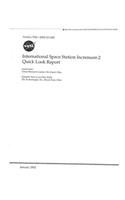
International Space Station Increment-2 Quick Look Report
Series:
The objective of this quick look report is to disseminate the International Space Station (ISS) Increment-2 reduced gravity environment preliminary analysis in a timely manner to the microgravity scientific community. This report is a quick look at the processed acceleration data collected by the Microgravity Acceleration Measurement System (MAMS) during the period of May 3 to June 8, 2001. The re
NaN
VOLUME
English
Paperback

The objective of this quick look report is to disseminate the International Space Station (ISS) Increment-2 reduced gravity environment preliminary analysis in a timely manner to the microgravity scientific community. This report is a quick look at the processed acceleration data collected by the Microgravity Acceleration Measurement System (MAMS) during the period of May 3 to June 8, 2001. The report is by no means an exhaustive examination of all the relevant activities, which occurred during the time span mentioned above for two reasons. First, the time span being considered in this report is rather short since the MAMS was not active throughout the time span being considered to allow a detailed characterization. Second, as the name of the report implied, it is a quick look at the acceleration data. Consequently, a more comprehensive report, the ISS Increment-2 report, will be published following the conclusion of the Increment-2 tour of duty. NASA sponsors the MAMS and the Space Acceleration Microgravity System (SAMS) to support microgravity science experiments, which require microgravity acceleration measurements. On April 19, 2001, both the MAMS and the SAMS units were launched on STS-100 from the Kennedy Space Center for installation on the ISS. The MAMS unit was flown to the station in support of science experiments requiring quasisteady acceleration data measurements, while the SAMS unit was flown to support experiments requiring vibratory acceleration data measurement. Both acceleration systems are also used in support of the vehicle microgravity requirements verification. The ISS reduced gravity environment analysis presented in this report uses mostly the MAMS acceleration data measurements (the Increment-2 report will cover both systems). The MAMS has two sensors. The MAMS Orbital Acceleration Research Experiment Sensor Subsystem, which is a low frequency range sensor (up to 1 Hz), is used to characterize the quasi-steady environment for payloads and ve...
Price Comparison [India]
In This Series
Bestseller Manga
Trending NEWS




















